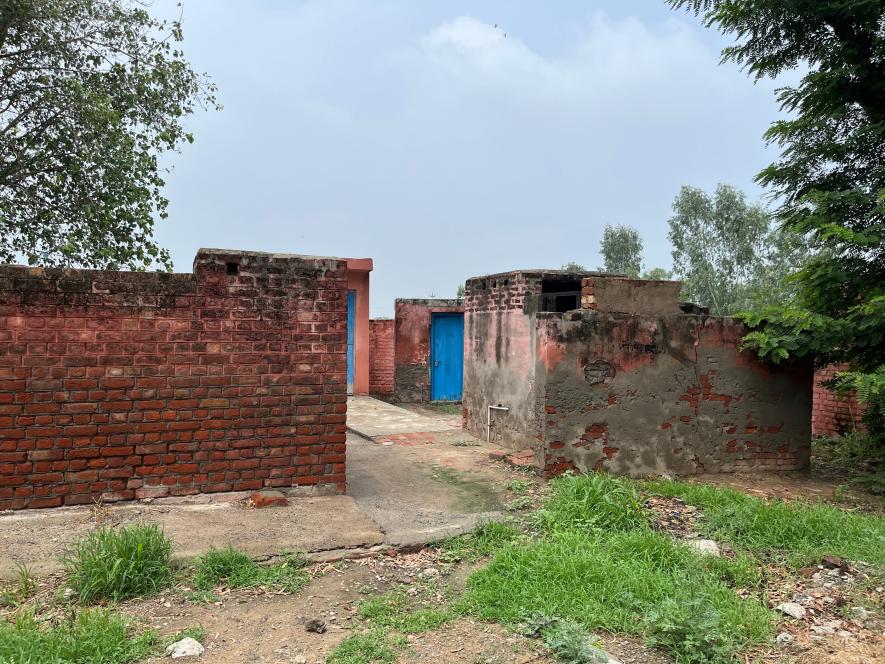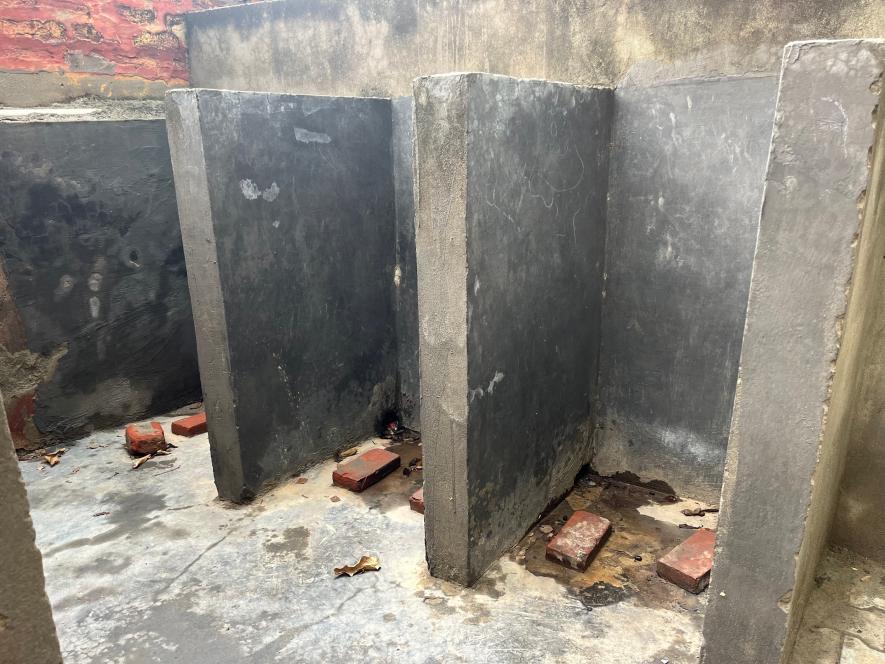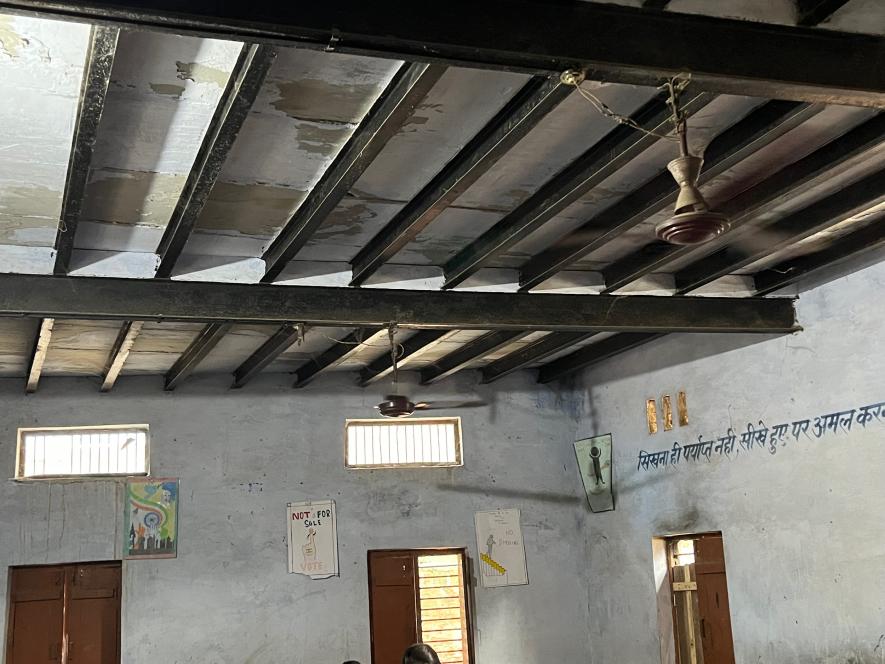Haryana: 8 Years of Neglect, Several Schools Without Roofs, Toilets

Classrooms being held under a tree at the government school in Kasandi.
“We did not even have money to get fans. The staff pooled their own money to buy them,” says Ram Chandra, principal of Government Senior Secondary School, Kasandi in Sonipat district. This makeshift solution speaks volumes about the crumbling façade of Haryana's public education sector.

Bathrooms at Government Senior Secondary School, Kasandi, Haryana
In 2024-25, the Haryana government allocated a mere 13.8% of its expenditure to education, lagging behind the national average of 14.7%. This consistent underfunding highlights the government's chronic neglect. Last year, the Haryana government underspent its education budget by nearly 8%, justifying a ₹2,411.08 crore reduction due to unfilled vacancies. By February 2024, government schools in the state faced a staggering shortage of 11,341 teaching and 16,537 non-teaching posts. Alarmed by these vacancies, the Punjab and Haryana High Court demanded an affidavit from the government.
Since 2017, the Haryana government has been under the High Court’s radar for its dismal handling of school infrastructure. Amarjeet and other students from Balu village in Kaithal district highlighted these stark problems through a petition. In May 2023, Anshaj Singh, Director of Secondary Education, filed an affidavit revealing that ₹1,176.38 crore of Central funds and ₹13,420.97 crore of state funds had gone unutilised over 10 years.
Government schools in Haryana continue to grapple with basic infrastructure deficiencies. Despite repeated promises, budget allocations and legal affidavits, the ground reality remains a testament to the persistent failure to prioritise education.
Under Open Skies
The harsh reality of Haryana's crumbling education infrastructure is laid bare by the government's own admission. In a 2023 affidavit, the state declared it needed ₹1,784.03 crore to meet infrastructural needs but had only ₹424.22 crore for the 2023-24 fiscal year—a mere 23.8% of the required amount.
The state’s economic survey of 2023-24 further underscored the dire situation, revealing that only ₹19.90 crore was allocated to the Haryana School Shiksha Pariyojna Parishad for building construction. According to the state government’s affidavit in the Punjab and Haryana High Court, 63% of schools in Haryana needed funds for classrooms, additional rooms, and boundary walls. More than a year after the affidavit, the situation remains unchanged.
The Government Senior Secondary School in Kasandi, the only senior secondary school in the village, stands testament to this neglect. The school boasts a decently large campus with a wide, green pathway, but its gateway is broken and gate-less, leaving it open for anyone who wishes to enter. Inside, the most striking aspect is the absence of classrooms. Students sit on benches under a shed in the peak humid weather of July, with teachers struggling to teach without blackboards.
“We have only three rooms now, which were initially computer and science labs, but we need space for our office and documents, so we’ve taken it over,” explains principal Ram Chandra, who was transferred to this school in 2020. Chandra recounts that the school had a fully functional campus with 18-19 classrooms for classes 6th to 9th. However, in 2021, the state government demolished these classrooms due to their old construction. The school has been waiting since then for a grant to build new classrooms.
“We finally received a grant of ₹75 lakh three months ago, but it's stuck in the tendering phase now. It took three years for just the grant to be issued, so we don’t know how much longer it will take now,” he tells this reporter.

Classrooms under a shed in a government school in Kasandi, Sonipat district.
Classes for every grade are conducted in various corners of this shed. The shed was constructed two years ago because students had nothing to sit under. Even today, the 6th grade studies under a tree. Chandra mentioned that since the demolition, they had updated the Ministry of Education’s Unified District Information for Education plus (UDISE+), that is, a student database management system for all student and school records for the Central government. They have reported that the number of students is 127, and the number of classrooms is zero, yet action is still delayed.
“We used to have a strength of 160-165 students, but now it has fallen. We try a lot to retain students and thankfully have immense support from our teachers,” he says.

Children attending class under a tree at the government school in Kasandi, Haryana.
Chandra claims that the ₹75 lakh grant is insufficient to meet the school's needs. “Imagine, with classes from 6th to 9th and more than 100 students, we need enough rooms not just for classes but also for a library, a science lab, an activities room, etc. With the grant issued so far, we can just barely start work on some basic classrooms,” he adds.
Bare Necessities: The State of School Bathrooms
In 2023, Anshaj Singh, Director of Secondary Education, assured the court that 131 drinking water facilities, 1,585 toilets (for boys and girls), and 236 electricity connections would be provided to schools through the school management committees on a priority basis within the 2023-24 financial year. However, the reality of Haryana’s government school bathrooms tells a different story.

The girl's bathroom in the government school in Kasandi.
The senior secondary school in Kasandi had constructed bathroom areas for boys and girls, including a bathroom for children with special needs. However, these facilities were far from functional. The girls' bathroom featured half-open toilet compartments without waste pipes, toilet bowls, or waste outlets. The girls said they used a single functional bathroom nearby but often resorted to the compartments for urination.
This was a common issue across the schools this reporter visited. Moreover, the toilets lacked taps or any access to water for handwashing. When asked about the missing taps, students said, "After using the bathroom, we go across the school near the entry gate where we have drinking water taps to wash our hands."

The girls’ bathroom at the government school in Chitana, Sonipat district.
The situation was even more dire at the Government School in Chitana in Sonipat district. Despite its larger, greener campus, the construction of the girls' bathroom mirrored that of Kasandi's, with students using bricks instead of a toilet bowl. A female teacher shared, “We have only three toilets that have a tap and a toilet bowl. For so many classes and teachers, we all end up using these spaces only.”

Female teachers’ bathroom at government school in Chitana.
In some segments of the female teachers' bathroom, there were no compartments, just placements of bricks. Additionally, neither the bathrooms in Kasandi nor Chitana had roofs.

Boys’ bathroom at the government school in Chitana, Haryana.
The situation in the Chitana school was particularly alarming, as it lacked even a basic structure for the boys' bathroom. Instead, a small area with just a boundary wall served as the designated boys' bathroom.
Crumbling Classrooms
The Government School in Chitana recently faced a horrifying incident when the roof of a classroom cracked and collapsed on two students during class. Although the students were injured, and that portion of the building was sealed, the state of the other classrooms remains perilous with visible seepage and damaged roofs. A veteran teacher remarked, “The incident was blown out of proportion in the news, but the real issue is the lack of funds. We barely receive ₹25,000 from the government annually. How can we ensure repair work for even one classroom with that amount?”

Classrooms at the Government School in Chitana, Haryana.
Classrooms at the school are dimly lit, each with a single lightbulb in a corner. The basic infrastructure, such as fans, were in a dilapidated state. The school relies on a submersible pump for drinking water, but frequent electricity cuts in the village make it difficult to access water. There are two hand pumps on the premises, but according to teachers, they have been non-functional for years with no repair work undertaken. “Sometimes when the electricity is out for an entire day, we have to send students to fetch water from a nearby lake. They go out with buckets to help us get water so we have something in the school. What else can we do?”

Classrooms at Government School in Chitana, Haryana
The boundary wall of the school, adorned with government slogans and caricatures, is severely damaged at several points.

The Boundary wall of Government School in Chitana.
A local resident Satbir explained, “Every time it rains, the road outside the school gets knee-deep in water, which then seeps into the school, making it difficult for students to reach or move inside the school.”

Waterlogged playground at the Government School in Pipli, Haryana.
After a day of heavy rain on July 31, 2024, the nearby Senior Secondary Government School in Pipli also experienced severe flooding across its grounds. Teachers claimed this was a frequent problem and, despite their efforts to get it repaired, the infrastructure was not robust enough to withstand heavy rains.
Model Sanskriti Schools
During visits to Haryana, this correspondent did encounter some government schools that boasted maintained infrastructure and amenities. The Government Senior Secondary School for Girls at Kharkhoda in Sonipat district, for instance, had two attached campuses—a primary school and a senior secondary school. While not as expansive as the campuses at Chitana and Kasandi, it featured well-maintained classrooms equipped with smart boards.
The primary school at Kharkhoda had been designated a ‘Model Sanskriti School’ by the Haryana government, which provided it with additional grants. In August 2020, the state government announced plans to develop 104 government schools as Model Sanskriti Schools. The then Chief Minister Manohar Lal Khattar promised that these schools would have trained staff and the necessary facilities to provide better education.
Despite this initiative, many classrooms at the primary school lacked tables and chairs for students. According to sources, the school had requested additional tables and classrooms, but these demands were still pending.
On July 19, 2024, Jitender Kumar, Director of Secondary Education Haryana, informed the Punjab and Haryana High Court in an additional affidavit that infrastructure work was at an advanced stage. Against the requirement of 8,240 additional classrooms, 751 had been constructed, 1,082 were in progress, and 1,917 were in the tendering process.
Given the infrastructure needs of 14,191 schools in the state government’s affidavit of 2023, the government's efforts fall woefully short. With a requirement of more than 8,000 additional classrooms, the construction of only about 4,000 classrooms shows a glaring gap and lack of urgency in addressing the crisis.
Despite close to eight years of scrutiny by the Punjab and Haryana High Court—through multiple affidavits, statements, and fines—the Haryana government continues to cruise through its broken responsibilities. How long will students have to pay the price for this negligence with their future?
Shubhangi Derhgawen is a freelance journalist based in Delhi.
Get the latest reports & analysis with people's perspective on Protests, movements & deep analytical videos, discussions of the current affairs in your Telegram app. Subscribe to NewsClick's Telegram channel & get Real-Time updates on stories, as they get published on our website.
























